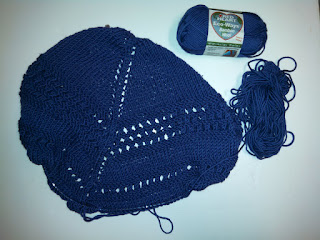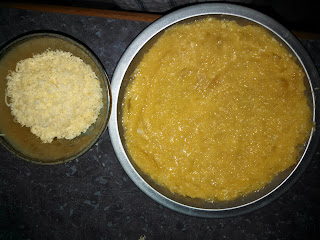First a sweater from one ball of Patons Classic Wool in "Commotion":

It was supposed to have a hood, but I didn't have enough yarn, even making the three-to-six months size, so gave it a placket and collar instead. I had fun rummaging through my button box and debated several other options until I found the lone card with three purple "jewel" buttons. Perfect! Why shouldn't an orphan have special buttons?
Similarly the ones on this sweater, although they are not the only star-shaped ones I have:

The yarn is oddballs of (I think) Cleckheaton and a ball of Noro Kureyon, and I used all of the blue and the Kureyon but have a bit of the green left. It's the Super-Natural Stripes Sweater in about 18 months size. I received a lot of compliments about it, including when I was knitting while waiting for the annual Om Street to begin (you can see me at it in the background of picture #107). The colours show up much better here - they really are bright, and one friend said quite classic:
It's almost hard to give that one away, but I have no use for it and some child will be warm.
Finally, a sweater that I had very little to do with. You see, my mother found an old knitting bag with pieces of two sweaters in it. She made them when my brother was an infant. They are nicely done but were never put together. Mom gave me permission to finish and donate them. I had time to do only one for this shipment, since the woman going to visit the baby house is leaving earlier than we expected. I chose the one that seemed to be more complete:
At the top is a back with two fronts attached at the shoulders. We're not sure what the middle piece is; I guessed a hood of some sort. And the two sleeves below. Since there was no other yarn and of course no instructions, I decided to use my best guesses, and to unravel the hood piece for yarn to finish the sweater.
First, set in the sleeves and sew side and underarm seams:
The fronts have no buttonholes and just touch, so I wonder if they are supposed to have a zipper? I don't have one, and I do have a lot of buttons, and I've heard that buttoned sweaters are more popular in FSU countries. How to adapt? I decide to knit on another six stitches in the same 1:1 ribbing, and attach it as I go. Like this:
For one side, I skip attaching every so often, to create buttonholes.
Then to finish the neckline, I added a ribbed collar:
And of course once some buttons were sewn on (the backside is very much prettier than the front, although the white side would have been fine too), it's a cute little cardigan!

So decades after it was first knitted for a then-little boy, hopefully it will keep some other little child warm. It's not the first time I've put together a decades-old UFO for my mother, and I said it's proof that dislike of sewing-together is genetic!















































